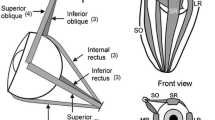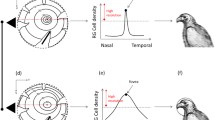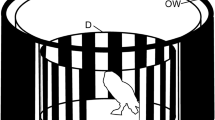Abstract
Video-records of the eye and head position of chameleons (two species) in relation to prey targets revealed the following:
-
1.
Foveal fixation is performed monocularly for object identification before chameleons decide to catch the prey.
-
2.
If the chameleon intends to catch the prey, it turns its head towards the prey in preparation for the tongue shoot. While turning its head, the fixating eye does not continue to keep the target fixed foveally. Rather, it adopts a diverging position to the head, the mediosagittal plane of which in the end is target-directed.
-
3.
Ready for tongue shoot, the position of both eyes to the head is definitely adjusted at a fixed diverging angle of 17–19 deg, and this position does not change at all with distance to the target.
-
4.
Chameleons are also able to perform tongue shoots successfully using only one eye (the other being occluded), and they use the same adjustment of prey to eye and eye to head as in the binocular case.
-
5.
Thus, the correct direction of the tongue shoot in chameleons is processed by an extrafoveal retinotopic depiction of the prey image using monocular distance information and a fixed eye in head position.
Similar content being viewed by others
References
Flanders M (1984) Visually guided head movement in the African chameleon. Vision Res 25:935–942
Harkness L (1977) Chameleons use accommodation cues to judge distance. Nature 267:346–349
Harkness L (1978) The deep fovea as a focus indicator. Nature 272:814–816
Kirmse W (1988) Foveal and ambient visuomotor control in chameleons (squamata) — experimental results and comparative review. Zool Jb Physiol 92:341–350
Kirmse W (1990) Kritische Übersicht zur selektiven Sensomotorik des Blickens und multifoveates Spähen bei Vögeln. Zool Jb Physiol 94:217–228
Kommerell G, Klein U (1971) Über die visuelle Regelung der Okulomotorik. Die optomotorische Wirkung exzentrischer Nachbilder. Vision Res 11:905–920
Lässig P, Kirmse W, Yekoye A (1987) Visuomotor control by a combined position- and speedservo. Theoretical considerations and experimental results in man. Syst Anal Model Simul 4:321–334
Ter Braak JWG, Buis C (1970) Optokinetic nystagmus and attention. Int J Neurol 8:34–42
Author information
Authors and Affiliations
Rights and permissions
About this article
Cite this article
Kirmse, W., Kirmse, R. & Milev, E. Visuomotor operation in transition from object fixation to prey shooting in chameleons. Biol. Cybern. 71, 209–214 (1994). https://doi.org/10.1007/BF00202760
Received:
Accepted:
Issue Date:
DOI: https://doi.org/10.1007/BF00202760




